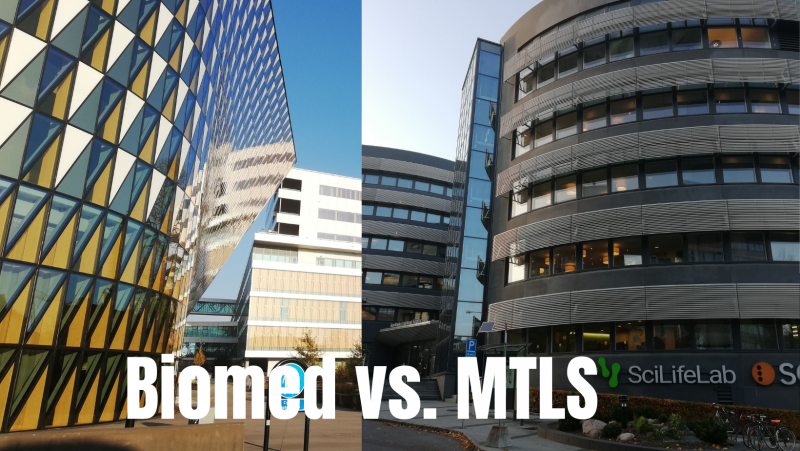
Biomedicine or MTLS? – Part 1
If you’re reading this blog, you may be asking yourself whether to choose Biomedicine or Molecular Techniques in Life Science (MTLS) for your Global Master’s application. As the digital ambassadors for these programmes, Alessandra and I often get asked what is the difference between these two Master’s degrees?
Generally speaking, both degrees are 120 credits or the equivalent of 2 full-time school years in duration. Most students coming from a biological or biomedical background will be choosing between these two programmes. But that’s pretty much where the overlap ends…
So if you’re wondering what are the differences and similarities between the Global Master’s in Biomedicine and the Joint Master’s in Molecular Techniques in Life Science, we are excited to break it all down for you in this 2-part blog!
Disclaimer: this blog’s content is simply our personal reflections on what our programmes look like and should be taken with a grain of salt. If you want to understand these programmes better, please consult the official course pages for the Master’s in Biomedicine and the Master’s in Molecular Techniques in Life Science on KI’s website.
Admission Requirements
The general guidelines for eligibility criteria vary a little from year to year, so it’s best if you follow the official webpage for these master’s programmes if you want to know more about admission requirements. However, it is worth pointing out that the prerequisites for MTLS are slightly more restrictive than the ones for Biomedicine, since we require a specific amount of credits in certain disciplines, e.g. mathematics.
Curriculum content and programme structure
| Biomedicine | Molecular Techniques in Life Science |
| Biomedicine = biology + health Fully at Karolinska Institutet (KI) Theory on CVD, immunology, neurological disorders, cancer, etc. Clinical visits – get to interact with patients once or twice. 2 courses in Bioinformatics (Python) and Biostatistics (R) – e.g. phylogenetic tree construction In the third semester, you get the option of choosing between 5 elective tracks – neuroscience, tumor biology, immunology and infection, cell biology, and metabolism. Training for animal handling (rodents) provided. Bioethics as part of one course. Two research project courses 6-month thesis project One Applied Communications course at KI | MTLS = biotech + bioinformatics Spread across 3 different universities – KI, SU, and KTH SciLifeLab facility visits Theory on techniques and emerging technologies to detect and diagnose pathologies (AD, PD, CVD, genetic diseases, etc.) Clinical applications of bioinformatics Multiple courses in Bioinformatics and Biostats – involve programming in Python, bash, R, PyMOL, and others Combination of wet lab and dry lab Ethics of biotechnologies and AI is widely discussed and explored in several of our courses One research project course in year-2 6-month thesis project One Applied Communications course at KI |
Assessment and grading
| Biomedicine | Molecular Techniques in Life Science |
| Grading scheme: Fail/Pass/Pass with Distinction Re-exam possible up to 6 times, ~ two chances to pass per semester Grade dependent mostly on theory assessment (exams or presentations) – individual grading Group assignments are graded as a group, not on an individual basis Peer-review/feedback in Applied Communications course | Grading scheme: KI: F/P/PwD SU: A/B/C/D/E/F KTH: A/B/C/D/E/F Re-exam possible up to 6 times; two chances to pass per semester Chance to re-do exam for a higher grade in some courses Grade is dependent on assignments and/or final exams Group assignments are graded as a group, not on an individual basis Peer-review/feedback in most courses, sometimes taken into consideration for individual grade on top of overall group grade |
Learning Styles
| Biomedicine | Molecular Techniques in Life Science |
| Presentations in groups for practical courses Peer feedback for group work Most theory courses rely on independent study Research projects are individual (but receive help from your research group) You learn the basics of programming in Python and R, but it’s not the main focus of the programme | Most courses involve teamwork – in some courses, you get to choose your teammates, while in others, you don’t (can be good or bad) For wet-lab projects, it’s very collaborative, there’s an element of experimental design and project planning For coding assignments, it can be easy if you’re paired up with someone who’s proficient in programming; on the other hand, it can be overwhelming if you have challenges acquiring the learning outcomes from the first couple programming courses Research projects can be individual or in pairs |
These first 4 categories in the battle of the programmes should have given you a taste of what the pros and cons of each Master’s are, according to our individual perspectives. Now, before you make any decision prematurely, go on and read the rest of our discussion in Alessandra’s blog, Biomedicine or MTLS? – Part 2.
Once again, for all official info, please check out the official course pages for the Master’s in Biomedicine and the Master’s in Molecular Techniques in Life Science on KI’s website.
Hopefully, I’ve convinced you that MTLS is the programme for you ; )
Good luck with your applications everyone!
Francisca Leonardo - Molecular Techniques and Life Sciences
Hej! My name is Francisca. I come from the faraway land of the supreme maple syrup, aka Canada. I’m the blogger for the Master’s Programme in Molecular Techniques in Life Science at Karolinska Institutet. I love to write about my experience as a student in my programme, a newcomer to Stockholm, and a rookie at life in general. In my free time, I enjoy playing tennis, making music, sketching the city’s landscapes, and reading about anything and everything that interests me.

0 comments